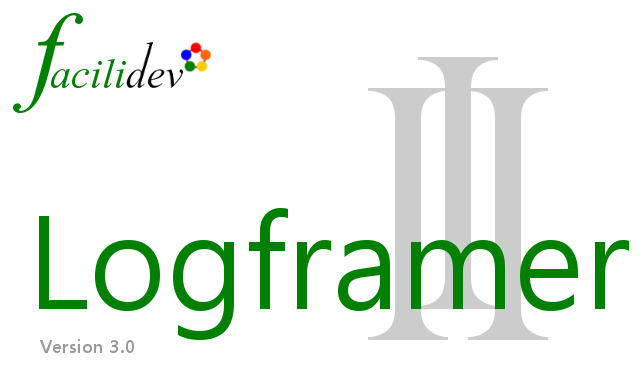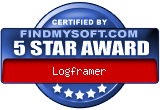What is Logframer?
Logframer 3.0 is a free project design and project management application. Originally, Logframer was designed to make the development of projects in international development and humanitarian assistance easier. But Logframer is also used by all kinds of social organisations, government administrations and even businesses. As its name suggests, Logframer uses the basic structure of the logical framework or logframe to describe various components of a project, such as the objectives, the activities, the resources as well as possible external influences on the project (risks, assumptions, issues and dependencies). But that doesn't mean you are obliged to use a logframe approach.

The basic idea behind Logframer is to provide aid actors such as NGOs, non-profit organisations, donor agencies and so on with a simple, versatile and free tool that makes designing and managing projects and programmes easier (and more fun). Logframer allows you to better integrate all information needed for a well-designed project, and helps you to improve the quality of your project proposals.
Logframer allows you to:
- Bring all project-related information together in a single document: objectives, activities, resources, planning, budget, target groups, partner organisations, etc.
- Follow up the lifecycle of your project
- Identify your target groups and make tools to register different types of beneficiaries or clients
- Select intervention zones and indicate them on a map (using Bing Maps™)
- Design the basic structure of your project (project logic or intervention logic)
- Identify assumptions, internal and external dependencies and risks and develop tools to monitor risks during your project
- Choose indicators to measure progress and results, plan monitoring and evaluation deadlines and reporting and develop tools to monitor progress and results during and after your project
- Plan activities and processes using a Gantt chart
- Establish the budget of your project and indicate how many resources you need for each activity and output
- Manage contact information about your partners and staff so that you can quickly communicate with them
- Export all this information to Microsoft Word or Microsoft Excel, so you can easily create funding proposals, training materials, etc.
- Create International Aid Transparency Initiative (IATI) activity and organisation files but also read and edit existing files
Logframer 3.0 is designed to replace the usual tools for designing a logical framework, such as MS Excel and Word. It also makes sharing easier because all the essential information of your project is gathered in one single file. This helps you deal with the fact that internet connections in some part of the world make it difficult to use cloud-based solutions. Logframer documents are light-weight, which is a big help if you're forced to push whole series of heavy documents over an internet connection that fails every couple of minutes.
Logframer offers many options but you are never obliged to use them all. This way, Logframer can help small grass-roots organisations develop simple projects, but it can also assist bigger organisations with the development of large and more complex projects and programmes. And once you're finished designing your project, you can create the necessary tools to manage it at the press of a button.
Logframer 3.0 can be used to design any project that uses a logical framework. Logframer has the necessary tools and options for Logical Framework Approach, Project Cycle Management and Results Based Management. But you can also use it for other approaches such as Outcome Mapping. You can modify the structure of the main window by hiding columns and sections and use 'soft' open-ended questions rather than 'hard' value-based indicators.





Comments
This is a great software for
This is a great software for us project managers.
Pueden poner la página en
Pueden poner la página en español?
Versión española
Querido Calima,
Me gustaría hacer una versión española de Logframer, pero por desgracia mi español no es lo suficientemente bueno para traducir también el sitio web en español. (Traduje esta respuesta a través de Google Translate, así que espero que tenga sentido). También sería demasiado trabajo para mí hacerlo por mi cuenta. La traducción de todo el sitio en un idioma adicional (francés) ya era una tarea enorme. Así que me temo que tengo que decepcionarte.
Saludos cordiales
Dear Calima,
I would like to make a spanish version of Logframer, but unfortunately my spanish is not good enough to also translate the website into spanish. (I translated this reply using Google Translate, so I hope it makes sense). Also it would be too much work for me to do on my own. Translating the whole site into one additional language (french) was already a huge task. So I'm afraid I have to disappoint you.
Kind regards
Web based application
Is there a plan to make Logframer a web based application so that users can login, modify and share?Thanks
Sharing via web
Yes, there is such a (cunning) plan. In fact it is already more than a plan: I have done initial tests and I was going to incorporate it in version 2.0. But much more work has to be done and because the planning for version 2.0 was already slipping I decided to postpone this feature until version 3.0
web based application
We have created a web based version of logframe & incorporated it to the intranet portal for an international NGO in Malaysia. I tried sharing the link to case study here but the spam filter does not allow me.
web based application
Hi Irfan,We want to do the same with logframe e.g. a web based application, would you share how have you proceed ?thanks !
web based application
Please share the link so we can also use the web-based application.
Log Frame History
A friend sent me the link to your web page and I am really glad that the Log Frame doesn't seem to be dead and done with. I was very much involved in the Log Frame adapation and the integration of problem- as well as objective trees ahead of the log frame program-/project design in the late 1980's for a leading German Development Cooperation Organization. I went to Washington DC to work with the consultant group which had designed the log frame, became a lead trainer and workshop facilitator for the "Objective Oriented Project Planning" and helped to implement the approch as an inhouse- and later free lance consultant in about 60 countries around the world.Now retired, I live in Brazil and would not have thought that the approach is still "alive" and implemented.Good luck for the concept, it's supporters and users.Regards,Uli
Add new comment